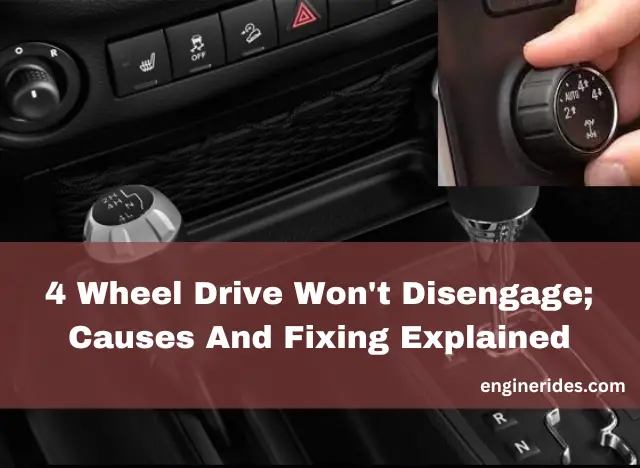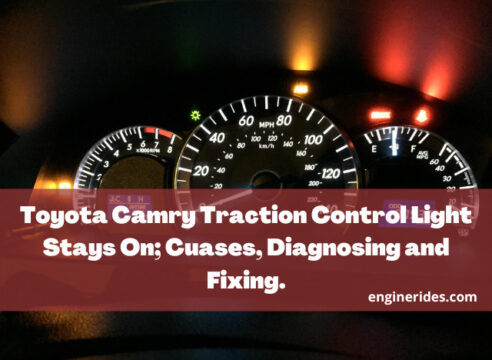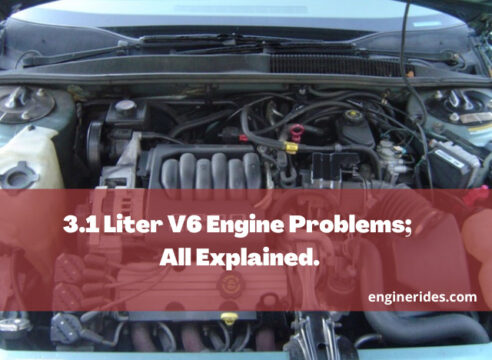4 Wheel Drive Won’t Disengage; Causes And Fixing Explained
A guy pulls up to my garage one day, saying his 4-wheel drive won’t switch off. I take a look and figure out what’s going on.
Here’s the deal: When you use 4-wheel drive, power goes to both the front and back wheels to help with traction. But when you switch back to regular driving, that connection should stop. Sometimes, though, after lots of driving or because of different things, parts in the system can get stuck together.
I figured out that the front and back tires aren’t spinning at the same speed, which messes things up. It’s like trying to walk with one leg longer than the other – it just doesn’t work right.
So, what’s the fix? I tell the guy to back up for a while to take the pressure off and help the parts let go. Sometimes, finding a spot where the tires can slide a bit while backing up helps.
But here’s the big idea: Making sure all the tires match – same size, same brand, and same amount of wear – can stop this problem from happening. Checking the transfer case and shift motor regularly is important too.
Now, let’s get into a deeper discussion on 4-wheel drive problems, focusing mostly on the not disengaging issue. Welcome to EngineRides.
What really happens in 4 Wheel drive system?

In a 4-wheel-drive system, power from the engine is sent to all four wheels of the vehicle, boosting traction and stability. This is managed by a transfer case, which splits power between the front and rear axles.
When engaged, all four wheels turn together, improving grip, especially in tough conditions like snow or mud. However, when turning, the front and rear wheels rotate at different speeds, causing stress and binding.
This can make disengaging 4-wheel drive tricky. Solutions include backing up to relieve tension, ensuring uniform tire specs, and regular maintenance to keep the system running smoothly.
When to use 4 Wheel drive?
You should use 4-wheel drive when you encounter conditions that demand extra traction and stability. This includes situations like driving on snow, ice, mud, sand, or rough terrain where grip might be compromised.
Engaging 4-wheel drive distributes power to all four wheels, which helps the vehicle maintain traction and control. Additionally, if you’re towing or carrying heavy loads, using 4-wheel drive can provide better stability and power distribution.
However, it’s important to remember that 4-wheel drive isn’t necessary for everyday driving on paved roads, and using it unnecessarily can increase fuel consumption and wear on the drivetrain components.
Can Stabilitrak Cause Car Not To Start? All You Need To Know
enginerides.com
When not to use 4 Wheel drive?
You should avoid using 4-wheel drive on dry, paved roads under normal driving conditions. Using 4-wheel drive when it’s not needed can actually cause unnecessary wear and tear on your vehicle’s drivetrain components and increase fuel consumption.
Also, engaging 4-wheel drive on high-traction surfaces can cause binding and stress on the drivetrain, especially during turns. This can potentially damage the system and lead to costly repairs.
In summary, it’s best to reserve 4-wheel drive for situations where extra traction and stability are necessary, such as driving on snow, ice, mud, sand, or rough terrain. Otherwise, stick to regular two-wheel drive mode for everyday driving on dry, paved roads.
4 Wheel drive won’t disengage; Causes and fixing

In my experience, issues with 4-wheel drive not disengaging typically stem from a few common causes. Here are four main ones along with their fixes:
01. Binding in the drivetrain
When the front and rear axles don’t spin at the same speed due to differences in tire size, tread wear, or mechanical issues, binding occurs.
To fix this, try backing up for a significant distance to relieve tension in the drivetrain. Ensuring all tires are the same size, brand, and tread depth can also prevent binding.
02. Faulty shift motor or transfer case:
If the shift motor or transfer case isn’t functioning properly, it can prevent disengagement of the 4-wheel drive. In this case, the fix may involve repairing or replacing the malfunctioning component.
03. Electrical issues
Sometimes, electrical problems such as faulty sensors or wiring issues can cause difficulties in disengaging 4-wheel drive. Troubleshooting the electrical system and addressing any issues found can resolve the problem.
04. Mechanical damage
In rare cases, mechanical damage to components within the 4-wheel-drive system, such as broken gears or worn-out parts, can prevent disengagement. Inspecting the system for damage and replacing any faulty parts is necessary to fix this issue.
Overall, diagnosing the specific cause of the 4-wheel-drive disengagement problem is crucial before implementing the appropriate fix. Consulting a qualified mechanic may be necessary for accurate diagnosis and repair.
Is it safe to drive when 4 Wheel Drive Won’t Disengage?
Driving with 4-wheel drive engaged when it won’t disengage can potentially be safe in certain conditions, but it’s not ideal for regular driving on dry roads. Here are a few considerations:
- Handling and Control
Driving with 4-wheel drive engaged on dry pavement can affect the vehicle’s handling and control. Since all four wheels are receiving power, it can lead to increased tire wear, decreased fuel efficiency, and potentially affect the steering and braking response.
- Road Conditions
If you’re driving on slippery surfaces like ice, snow, or mud, having a 4-wheel drive engaged might not be an issue. In fact, it can provide better traction and stability in such conditions.
- Mechanical Strain
Keeping 4-wheel drive engaged when it won’t disengage might put extra strain on the drivetrain components such as the transfer case, differentials, and axles. This could lead to premature wear and potential mechanical failures if not addressed.
- Seek Professional Help
If your 4-wheel drive system won’t disengage, it’s important to have it checked by a qualified mechanic as soon as possible. Driving with a malfunctioning 4-wheel drive system can potentially lead to more serious issues down the road.
In conclusion, while it might be safe to drive short distances with 4-wheel drive engaged on dry roads, it’s not recommended for regular driving. It’s important to have the issue diagnosed and repaired by a professional mechanic to ensure the safety and longevity of your vehicle.
Can you disconnect 4 wheel drive?
Yes, you can disconnect the 4-wheel drive by removing the fuse that powers the transfer case shift control module ECU and the transfer case encoder motor. This action cuts power to these components, effectively disabling the 4WD system.
By removing the fuse, you interrupt the electrical circuit that controls the engagement of the transfer case, preventing it from sending power to all four wheels. This method effectively disengages 4-wheel drive operation and allows the vehicle to function in 2-wheel drive mode until the issue with the 4WD system is resolved or further repairs are undertaken.
Can you switch 4WD to 2WD?

Modern vehicles often allow drivers to switch from 4WD to 2WD while moving, offering flexibility and convenience. This capability is facilitated by advanced drivetrain and electronic systems that can seamlessly adjust power distribution to the wheels without requiring the vehicle to come to a complete stop.
In contrast, older vehicles typically necessitate stopping before shifting between 4WD and 2WD modes due to mechanical limitations and lack of real-time control mechanisms. The ability to switch modes while driving enhances driver control and adaptability, particularly in rapidly changing road conditions where adjustments to traction and stability are necessary for safe operation.
Is it better to use 2WD or 4WD?
Here’s a comparison table outlining the advantages and considerations of using 2WD (Two-Wheel Drive) and 4WD (Four-Wheel Drive) systems:
| Aspect | 2WD (Two-Wheel Drive) | 4WD (Four-Wheel Drive) |
|---|---|---|
| Traction | Good on regular roads and dry surfaces | Excellent on off-road terrain and in snow |
| Fuel Efficiency | Generally better | Usually lower due to added weight and drag |
| Handling | Typically easier | Can be more stable in adverse conditions |
| Cost | Lower initial cost and maintenance | Higher initial cost and upkeep |
| Maintenance | Fewer components to maintain | More complex system may require more upkeep |
| Versatility | Limited off-road capability | Superior off-road performance |
| Resale Value | May have lower resale value | Can retain higher resale value |
| Ideal Conditions | Urban driving, highways, mild terrain | Off-road driving, snow, rugged terrain |
In summary, the choice between 2WD and 4WD depends on factors such as driving conditions, terrain, and personal preference.
2WD is generally more fuel-efficient and suitable for regular driving conditions, while 4WD provides superior traction and performance in off-road and adverse weather situations. It’s important to assess your driving needs and environment to determine which system is better suited for your requirements.
Drag Link vs. Tie Rod; Complete Comparison
enginerides.com
Which is safer 2WD or AWD?
In terms of safety, all-wheel drive (AWD) generally offers better traction and stability compared to two-wheel drive (2WD). AWD systems distribute power to all four wheels, enhancing grip and traction on slippery or uneven surfaces, and improving stability during acceleration and cornering.
This feature is particularly advantageous in adverse weather conditions like rain, snow, or ice, where maintaining control is critical for safety. While 2WD vehicles are adequate for normal driving conditions, AWD provides an additional layer of safety, especially in challenging environments.
Ultimately, AWD’s enhanced traction and stability contribute to safer driving experiences, especially in unpredictable road conditions.
Some related FAQs
Does 4WD have traction control?
Yes, many modern 4WD (Four-Wheel Drive) vehicles come equipped with traction control systems. These systems work in conjunction with the 4WD system to manage wheel slip and optimize traction on various surfaces. Traction control helps prevent wheels from spinning excessively by modulating engine power and applying brakes to individual wheels, enhancing stability and control, especially in challenging driving conditions such as snow, mud, or sand.
How do I know if my 4WD actuator is bad?
Signs of a bad 4WD actuator include difficulty engaging or disengaging 4WD mode, clicking or grinding noises from the transfer case, and the 4WD indicator light not illuminating or flashing. Additionally, if the vehicle struggles to shift between 4WD modes or experiences power loss, the actuator may be faulty.
Do you have to be in neutral to switch to 4WD?
In many vehicles, especially older models with manual transfer cases, shifting into 4WD typically requires the vehicle to be in neutral. However, modern vehicles with electronic transfer cases may allow shifting into 4WD without being in neutral, as long as the vehicle is traveling at a low speed or stationary.
How do you test a 4×4 control module?
To test a 4×4 control module, use a diagnostic scanner compatible with your vehicle’s make and model. Connect the scanner to the OBD-II port and access the control module. Perform system tests to check for fault codes, monitor sensor data, and verify proper communication between the module and other vehicle components.







